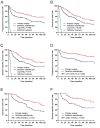Treatment Outcomes of Squamous Cell Carcinoma of the Soft Palate and the Prognostic Significance of HPV/p16 Status
- PMID: 40145145
- PMCID: PMC12248274
- DOI: 10.1002/hed.28143
Treatment Outcomes of Squamous Cell Carcinoma of the Soft Palate and the Prognostic Significance of HPV/p16 Status
Abstract
Background: Squamous cell carcinoma of the soft palate (SCCSP) represents a rare subtype of oropharyngeal cancer. This study aims to evaluate the treatment outcomes of SCCSP and to assess the prognostic significance of HPV status.
Methods: Patients diagnosed with SCCSP between January 1981 and December 2021 were collected. Survival outcomes were compared.
Results: In univariate analysis, primary surgery resulted in superior progression-free survival (PFS), overall survival (OS), and disease-specific survival (DSS) compared with definitive radiotherapy (p < 0.05). Furthermore, multivariate analysis revealed that primary surgery independently correlated with superior PFS (HR = 0.37, p = 0.002), OS (HR = 0.55, p = 0.012), and DSS (HR = 0.45, p = 0.020) in early-stage SCCSPs. Additionally, no significant prognostic differences were observed between HPV/p16 positive and HPV/p16 negative SCCSPs (p > 0.05).
Conclusion: Surgery yields superior oncological outcomes for early-stage SCCSP patients. HPV status does not demonstrate prognostic significance in SCCSP.
Keywords: HPV; oropharyngeal cancer; prognosis; radiotherapy; surgery; treatment.
© 2025 The Author(s). Head & Neck published by Wiley Periodicals LLC.
Conflict of interest statement
Figures


Similar articles
-
HPV Status and Survival Outcomes in Patients 70 Years and Older After Surgery for Oropharyngeal Carcinoma.JAMA Otolaryngol Head Neck Surg. 2025 Aug 1;151(8):795-805. doi: 10.1001/jamaoto.2025.1722. JAMA Otolaryngol Head Neck Surg. 2025. PMID: 40608315
-
HPV-Positive Oropharyngeal Carcinoma: A Systematic Review of Treatment and Prognosis.Otolaryngol Head Neck Surg. 2015 Nov;153(5):758-69. doi: 10.1177/0194599815592157. Epub 2015 Jun 29. Otolaryngol Head Neck Surg. 2015. PMID: 26124261
-
Impact of Margins on Outcomes in HPV-Related Oropharyngeal Squamous Cell Carcinoma Treated With Surgery Only.Otolaryngol Head Neck Surg. 2025 Jul;173(1):106-114. doi: 10.1002/ohn.1213. Epub 2025 Mar 19. Otolaryngol Head Neck Surg. 2025. PMID: 40105423
-
Analysis of HPV and NKG2D rs1049174 Polymorphism in Vietnamese Patients With Oropharyngeal Squamous Cell Carcinoma.Cancer Control. 2025 Jan-Dec;32:10732748251362943. doi: 10.1177/10732748251362943. Epub 2025 Aug 12. Cancer Control. 2025. PMID: 40795938 Free PMC article.
-
Predictive value of human papillomavirus in oropharyngeal carcinoma treated with radiotherapy: An updated systematic review and meta-analysis of 30 trials.Head Neck. 2014 May;36(5):750-9. doi: 10.1002/hed.23351. Epub 2013 Oct 7. Head Neck. 2014. PMID: 23606404
References
-
- Chi A. C., Day T. A., and Neville B. W., “Oral Cavity and Oropharyngeal Squamous Cell Carcinoma—An Update,” CA: a Cancer Journal for Clinicians 65 (2015): 401–421. - PubMed
-
- Gelwan E., Malm I.‐J., Khararjian A., Fakhry C., Bishop J. A., and Westra W. H., “Nonuniform Distribution of High‐Risk Human Papillomavirus in Squamous Cell Carcinomas of the Oropharynx: Rethinking the Anatomic Boundaries of Oral and Oropharyngeal Carcinoma From an Oncologic HPV Perspective,” American Journal of Surgical Pathology 41 (2017): 1722–1728. - PubMed
MeSH terms
Substances
LinkOut - more resources
Full Text Sources

